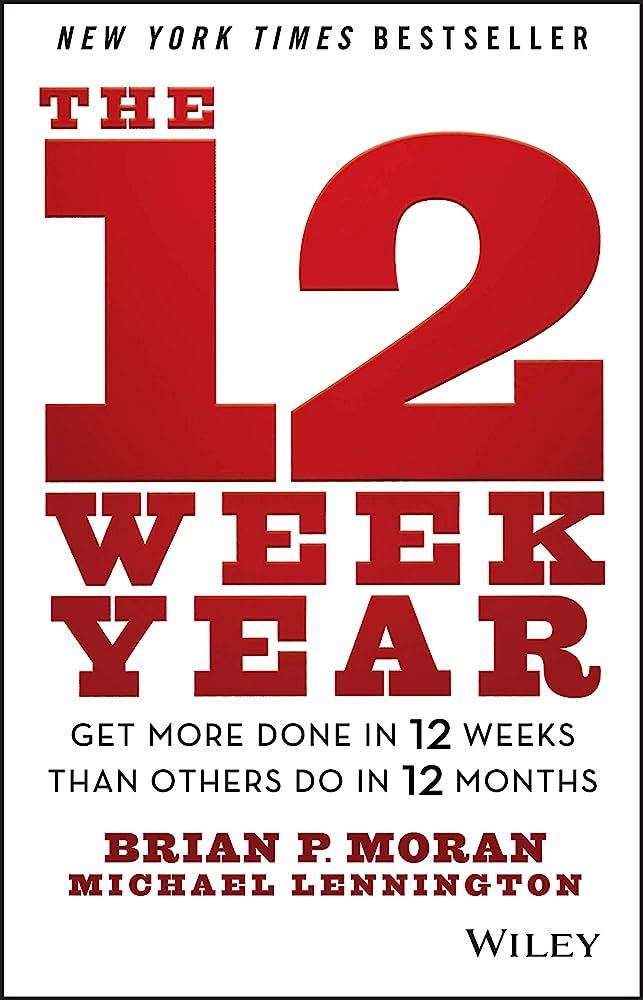In the fast-paced world of productivity, the quest for efficient planning, time management, and effective execution is a common challenge. The allure of achieving more in less time prompted authors Brian P. Moran and Michael Lennington to introduce the concept of the 12-Week Year. In their book, “The 12 Week Year: Get More Done in 12 Weeks than Others do in 12 Months,” Moran and Lennington present a groundbreaking philosophy that redefines the traditional yearly planning cycle, fostering greater focus, urgency, and success. Here is how I will be incorporating the 12-Week Year philosophy into my own life using the key takeaways of the 12-Week Year philosophy as well as the template I’ll be using.

The 12-Week Year
Crush your goals in just 12 weeks.
In The 12 Week Year, Brian Moran and Michael Lennington reveal a game-changing system that helps you ditch annual plans and achieve more in 3 months than most do in a year. Boost your focus, build urgency, and finally get things done.
Understanding the 12-Week Year
Traditional yearly planning can lead to procrastination and lack of urgency. The 12-Week Year introduces the concept of shorter planning cycles, boosting focus and accountability. By breaking down your annual goals into 12-week sprints, you create a sense of urgency and increase the likelihood of success.
The 12 Week Year Philosophy
Moran and Lennington outline an “execution system” comprising three core principles and five disciplines, all geared toward taking control of daily life.
Core Principles:
- Accountability: Taking full ownership of actions and consequences.
- Commitment: Doing whatever it takes to achieve set goals.
- Greatness in the Moment: Living in the present, applying self-discipline to take necessary actions.
Disciplines
- Vision: Defining personal aspirations that drive short- and mid-term goals.
- Planning: Focusing efforts on initiatives that bring the vision to life.
- Process Control: Utilising tools to align daily actions with the plan.
- Measurement: Scoring success through comprehensive progress tracking.
- Intentional Time Use: Approaching time with clear intentions for maximum efficiency.
Benefits of a 12-Week Execution Cycle
- Increased Predictability: Planning in 12-week cycles minimises the impact of random events, allowing for more accurate and achievable plans.
- Greater Focus: The urgency of a shorter time frame compels individuals to concentrate on achieving breakthrough results.
- Improved Structure: The condensed period provides a clear structure for setting well-defined goals, aligning day-to-day actions with long-term vision.
How to Implement The 12-Week Year
Creating Your 12-Week Plan
1. Establish a Compelling Vision
- Envision long-term goals and decide on three-year milestones.
- Regularly revisit and reinforce your vision for motivation.
2. Create Your First 12-Week Plan
- Focus on no more than three goals, ensuring they are SMART (Specific, Measurable, Achievable, Relevant, Time-based).
- Work out daily actions, considering challenges and potential solutions.
3. Create an Action Plan for Each Goal
- Break down goals into weekly and daily actions.
- Develop a list of distinct, clearly defined activities supporting longer-term objectives.
4. Schedule Regular Reviews
- Reflect on progress at the start of each week.
- Conduct a deep dive “final review” at the end of every 12-week period.
High-Level Tips for Success
1. Keep Score to Confront the Truth
- Use leading and lagging indicators to measure progress.
- Implement a weekly scorecard to objectively track actions completed.
2. Leverage Intentionality
- Utilise the Performance Time system for intentional time management.
- Employ strategic, buffer, and breakout blocks for focused work, handling interruptions, and rejuvenation.
3. Use Peer Support as Process Control
- Establish a Weekly Accountability Meeting for progress reporting, feedback, success sharing, and motivation.
Common Mistakes to Avoid
- Setting Unrealistic Goals:
- Goals should be achievable within a 12-week timeframe.
- Break large goals into manageable, shorter goals.
- Biting Off More Than You Can Chew:
- Gradually adapt to the 12-Week Year system.
- Begin with realistic expectations to avoid burnout.
- Avoiding Progress Reviews:
- Regularly track and review progress.
- Adapt strategies based on insights gained during reviews.
Download A Free 12-Week Year Template
To kickstart your journey towards a more productive and focused life, I’ve prepared a 12-Week Year Template (PDF) that you can download and use for your planning. This editable template will help you structure your goals, actions, and reviews in alignment with The 12-Week Year philosophy. Feel free to download your template now and embark on a transformative experience with The 12-Week Year.
Final Thoughts
The 12-Week Year offers a transformative approach to productivity, breaking down annualised thinking and instilling a sense of urgency for tangible results. Embrace accountability, commitment, and living in the moment to unlock the potential of this system. By avoiding common mistakes and following high-level tips, you’ll find yourself on a path of continuous improvement and achievement. As you embark on your 12-week journey, remember to stay focused, stay intentional, and celebrate the milestones along the way.




